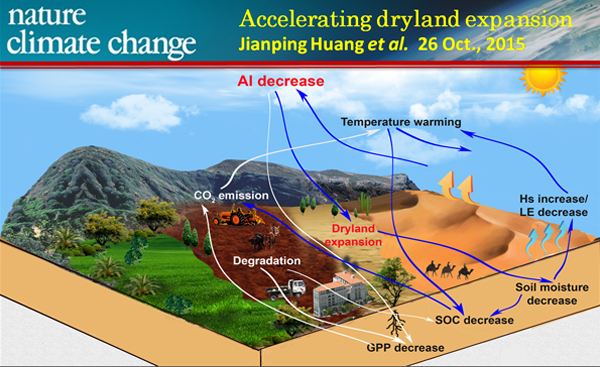
The latest research results from professor huang jianping and others from the school of atmospheric sciences, lanzhou university, were published in Nature Climate Change, a leading international journal on Climate Change, under the title Accelerated dryland expansion under Climate Change.If global emissions of greenhouse gases continue to rise, the expansion of arid and semi-arid regions will accelerate, accounting for more than 50 percent of the world's land surface by the end of the 21st century, the study said.Three-quarters of the global expansion of arid and semi-arid regions will occur in developing countries, which will put them at risk of further land degradation and exacerbate poverty in those regions.
Arid and semi-arid regions refer to regions where precipitation cannot compensate for surface evaporation and vegetation transpiration.Currently, arid and semi-arid regions account for about 40% of the world's land surface area. Affected by human activities such as population growth, urbanization and climate change, arid and semi-arid regions will continue to expand globally.Studies have shown that most of the current climate system models can not well simulate the extent of global arid and semi-arid regions.By comparing observations and simulations of climate models over the past 60 years, huang and his team confirmed that climate system models significantly underestimated the rate of global drought evolution.They further used historical observations to revise climate system model simulations to better reflect changes in the global arid and semi-arid regions.Correction of the model data was used to predict the future secondary emission scenarios (RCP4.5) and high emissions scenario (RCP8.5) under arid and change characteristics of arid area, found that under the high emissions scenario, the 21st century compared arid half arid area in 1961-1990 climate area will increase by 23% on average, while 78% of arid and half arid area of expansion will take place in developing countries.The study also shows that the warming trend of arid and semi-arid regions is significantly higher than that of humid regions, and that the combined effects of climate warming, intensified drought and population growth will increase the risk of desertification in developing countries, thus further expanding regional differences in global economic development.The study reinforces the urgency of reducing greenhouse gas emissions and combating global desertification.
The research is jointly funded by the national major scientific research program "climate change and its impacts in typical arid and semi-arid regions around the world" with professor huang jianping as the chief scientist and the special project of the public interest industry "improving 1-5 days of numerical prediction using historical data GRAPES model".More than a decade, jian-ping huang team around the arid and semi-arid Climate Change the international forefront of important scientific problems, carried out the unique and in-depth system of scientific research, has made a series of strong, with high influence basic original research achievements, won the second prize of national natural science in 2013, and in the international top journals published a series of high level papers, fifth assessment report cited by the IPCC, be Nature Climate Change, "a team" and so on several selected as the research highlights.The research paper published in Nature Climate Change was jointly completed by four students with an average age of only 28 in the team led by huang jianping, marking that the semi-arid Climate Change research results of huang jianping's team have reached the advanced level in the world.
Results link:http://www.nature.com/nclimate/journal/vaop/ncurrent/full/nclimate2837.html
 English
>
Scientific Research
>
Research Result
>
Content
Research Result
English
>
Scientific Research
>
Research Result
>
Content
Research Result